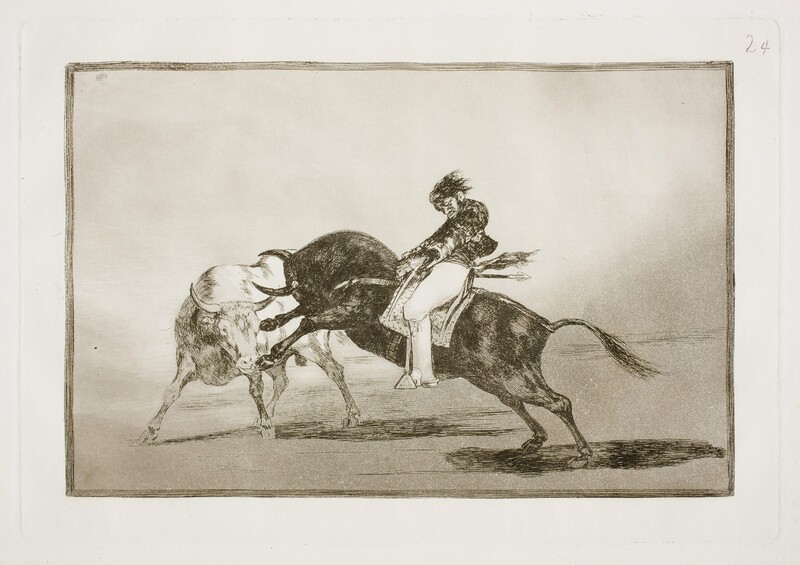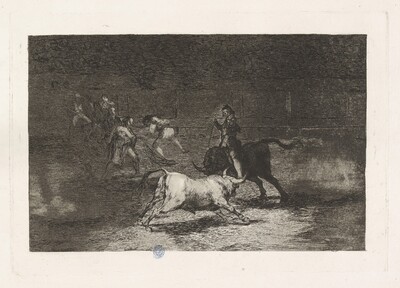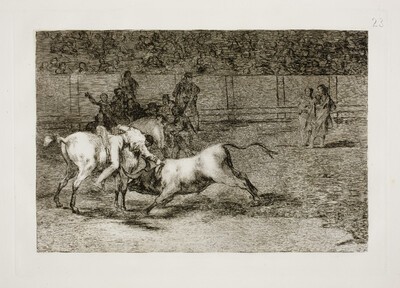- Cronología
- 1814 - 1816
- Dimensiones
- 243 x 353 mm
- Técnica y soporte
- Aguafuerte, aguatinta, punta seca, buril y bruñidor
- Reconocimiento de la autoría de Goya
- Documented work
- Ficha: realización/revisión
- 02 Oct 2021 / 22 Jun 2023
- Inventario
- -
24 (print, upper right-hand corner)
See How the ancient Spaniards hunted bulls on horseback in the countryside
There is a state proof before aquatint, burnisher, drypoint, burin and number addition.
The plate is kept at the National Chalcography (nº 357).
See How the ancient Spaniards hunted bulls on horseback in the countryside
Second of the three prints dedicated to bullfighting (Nos. 23 and 24) and its extensions (J) to Mariano Ceballos, aka "The Indian", a famous bullfighter from the time of Goya's youth, originally from Spanish America, specifically from the Governorate of the Silver Riber, part of nowadays Argentina.
In the picture we can see how Ceballos rides a rearing bull that he is trying to subdue and is holding a rejón in his right hand, which he intends to thrust into the other bull, which in the scene is shown in a prominent foreshortened position. The contrast between the two bulls one black and the other white, stands out, as does the contrast between the bullfighter´s clothes, also black and white, in such a way as to create a very characteristic dynamism, increased if possible by the fact the background is nude, slightly tinged by the burnished aquatint.
Due to its specific theme of a confrontation between two bulls, the work is particularly related to two other prints by Goya featuring Mariano Ceballos: Mariano Ceballos riding a bull with a rejón (Tauromaquia J) and The Famous American, Mariano Ceballos, a lithograph belonging to the series of the Bordeaux Bulls. According to Lafuente Ferrari, Ceballos performed the faena in Spain after coming from America, specifically in Pamplona in 1778, a city where he had already fought in 1773, 1774 and 1775. Salas, for his part, aware that Ceballos repeated this faena in various Spanish bullrings and not only in Pamplona, believes that Goya may have witnessed it as a young man, no doubt in Saragossa or Madrid, and that it had a profound effect on him, as at least he also depicted it in the other two works mentioned above.
Bagüés emphasises the treatment of Ceballos's face, which is clearly making a great effort to contain the impulses of the bull he is riding.
Holo places the work among the Bullfighting prints that have no background (Nos. 3, 5, 9, 10, 11, 12 and 16), in which we see the protagonists in an empty, almost abstract space. They are normally centralised compositions in which the attention is directed towards where the action is taking place. Martínez-Novillo, for his part, believes that the work is perhaps one of the earliest depictions of the American "rodeo" and includes it with the Bullfighting prints depicting particular tricks (nos. 14, 15, 16, 18, 19, 20, 23 and 24).
There is a preparatory drawing of this engraving, also titled The same Ceballos mounted on another bull that broke "rejones" in the bullring of Madrid
-
Grabados y dibujos de Goya en la Biblioteca NacionalBiblioteca NacionalMadrid1946catalogue Elena Páez Ríos
-
Goya en la Biblioteca Nacional. Exposición de grabados y dibujos en el sesquicentenario de su muerteBiblioteca NacionalMadrid1978May - June 1978
-
Grabados de Goya: colección propiedad de la Biblioteca Nacional, que se conserva en su Gabinete deCasa de la Amistad de MoscúMoscow1979exhibition displayed from January 18th to 31st 1979
-
1984
-
Madrid1987
-
Madrid1990
-
Goya grabadorFundación Juan MarchMadrid1994consultant editors Alfonso E. Pérez Sánchez and Julián Gállego, from January 14th to March 20th 1994
-
Goya grabadorMuseo del Grabado Español ContemporáneoMarbella1996from March 8th to May 5th 1996
-
Zaragoza1996
-
Ydioma universal: Goya en la Biblioteca NacionalBiblioteca NacionalMadrid1996from September 19th to December 15th 1996cat. 278
-
Schlaf der Vernunft. Original radierungen von Francisco de GoyaMunich2000
-
Madrid2002
-
Francisco de Goya. El proceso creativo de los CaprichosMuseo Nacional del PradoMadrid1999
-
Goya en tiempos de guerraMuseo Nacional del PradoMadrid2008consultant editor Manuela B. Mena Marqués, from April 14th to July 13th 2008cat. 153
-
Bilbao2012
-
Zaragoza2017
-
ZaragozaTip. del Hospicio1926pp. 33-34
-
1946pp. 177-216, espec. pp. 201-202
-
BarcelonaTartessos-F. Oliver Branchfelt1946 (reed. 1951)
-
1955pp. 145-147
-
1961pp. 120-127
-
OxfordBruno Cassirer1964vol. II, 1964, p. 340, cat. 227
-
Vie et ouvre de Francisco de GoyaParísOffice du livre1970p. 279, cat. 1198
-
MilwakeeMilwaukee Art Museum1986pp. 18-19, 24-25 y 32
-
Goya, toros y torerosMadridMinisterio de Cultura, Comunidad de Madrid1990p. 107, cat. 39
-
MadridCaser-Turner1992p. 34
-
Catálogo de las estampas de Goya en la Biblioteca NacionalMadridMinisterio de Educación y Cultura, Biblioteca Nacional1996cat. 347
-
Ydioma universal: Goya en la Biblioteca NacionalMadridBiblioteca Nacional, Sociedad Estatal Goya 96 y Lunwerg1996p. 249
-
MadridMuseo Nacional del Prado2001pp. 81-83
-
MadridMuseo Nacional del Prado y Ediciones El Viso2008pp. 430-431, cat. 153
-
Goya. In the Norton Simon MuseumPasadenaNorton Simon Museum2016pp. 186-201




